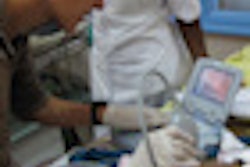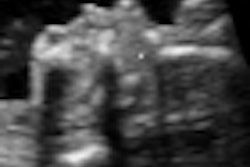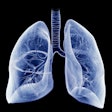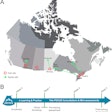In contrast to transient elastography methods, real-time elastography can reliably measure liver stiffness in patients with ascites, according to research published in the June edition of the American Journal of Roentgenology.
A group from Ehime University Graduate School of Medicine in Japan found that real-time elastography produced similar elasticity ratios before and after artificial ascites were implanted for radiofrequency ablation. Similar results were also found in patients with ascites from cirrhosis.
"This method has the potential of being superior to transient elastography for assessment of liver stiffness, particularly in patients with decompensated cirrhosis," wrote the research team led by Dr. Masashi Hirooka (AJR, June 2011, Vol. 196:6, pp. W766-W771).
While transient elastography can effectively assess liver fibrosis by measuring liver elasticity, the technique is limited in severely obese patients or those with ascites (an excessive accumulation of fluid); elastic waves do not propagate through liquids. Real-time elastography, however, has more potential for precisely evaluating liver stiffness because it transmits numerous pulses and utilizes mean values of the frames, according to the authors.
In addition, elasticity can be measured with slight compression or relaxation of the body. Echo signals are captured in real-time, and the technique facilitates anatomic correlations by simultaneously displaying tissue elasticity images and conventional B-mode images, according to the group.
To test if real-time tissue elastography could sufficiently evaluate liver stiffness in patients with ascites, the researchers evaluated 54 patients who were being treated at their university hospital from January to December 2009.
Of these 54 patients, 42 received real-time elastography to assess liver stiffness before and after injection to produce artificial ascites for radiofrequency ablation. The remainder had ascites due to cirrhosis and underwent real-time elastography before and after control of ascites, according to the authors.
Hepatic elasticity was measured with an EUB-7500 ultrasound scanner (Hitachi Medical Systems), using an EUP-L52 linear probe (Hitachi) with a central frequency of 5.5 MHz. B-mode was utilized first to visualize the liver, followed by the elastographic mode.
The researchers determined that the mean elastic ratio was 3.78 ± 0.87 before artificial ascites injection and 3.75 ± 0.76 afterward. The difference was not statistically significant (p = 0.973).
In the 12 patients who had ascites due to cirrhosis, the mean elastic ratio was 5.46 ± 0.52 before ascites was controlled and 5.51 ± 0.45 afterward. The difference also was not statistically significant (p = 0.766).
In both patient groups, neither the amount of ascites nor the distance between the abdominal skin and liver surface appeared to influence the elastic ratio.
"Stable values thus were measured with real-time tissue elastography," the authors wrote.
The researchers concluded that real-time elastography can reproducibly measure liver stiffness, even in patients with ascites.
"Because transient elastography cannot be used to evaluate liver stiffness in patients with cirrhosis and ascites, the real-time tissue elastographic method may have better potential than transient elastography for identification of liver stiffness," the authors wrote.
"Moreover, real-time tissue elastography is noninvasive and is associated with less sampling error than liver biopsy and thus has advantages for both clinicians and patients when data on liver stiffness are needed to determine suitable treatment and evaluate prognosis," they concluded.




















